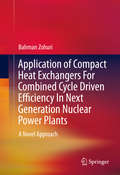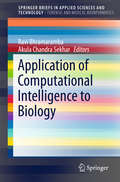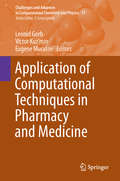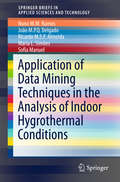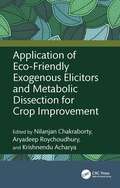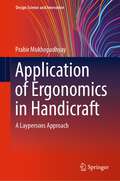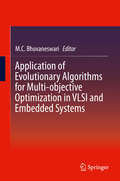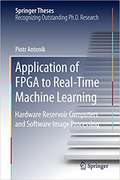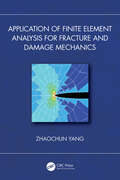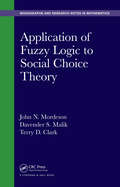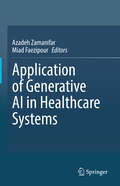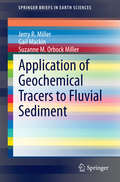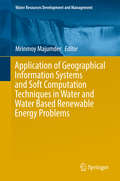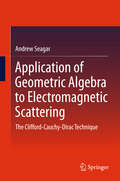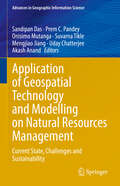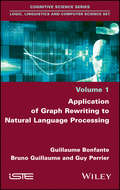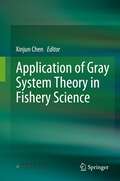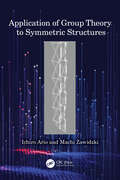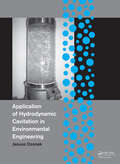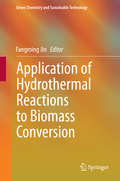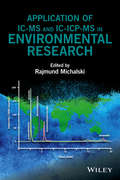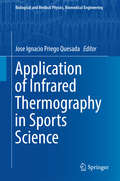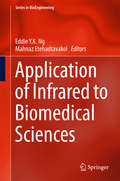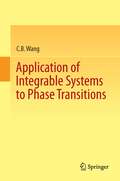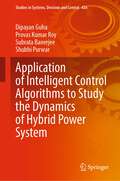- Table View
- List View
Application of Compact Heat Exchangers For Combined Cycle Driven Efficiency In Next Generation Nuclear Power Plants: A Novel Approach
by Bahman ZohuriCovers the fundamentals of combined-cycle plants to provide background for understanding the progressive design approaches at the heart of the text Discusses the types of compact heat exchanger surfaces, suggesting novel designs that can be considered for optimal cost effectiveness and maximum energy production Undertakes the thermal analysis of these compact heat exchangers throughout the life cycle, from the design perspective through operational and safety assurance stages This book describes the quest to create novel designs for compact heat exchangers in support of emergent combined cycle nuclear plants. The text opens with a concise explanation of the fundamentals of combined cycles, describing their efficiency impacts on electrical power generation systems. It then covers the implementation of these principles in nuclear reactor power systems, focusing on the role of compact heat exchangers in the combined cycle loop and applying them to the challenges facing actual nuclear power systems. The various types of compact heat exchanger surfaces and designs are given thorough consideration before the author turns his attention to discussing current and projected reactor systems, and how the novel design of these compact heat e xchangers can be applied to innovative designs, operation and safety analyses to optimize thermal efficiency. The book is written at an undergraduate level, but will be useful to practicing engineers and scientists as well.
Application of Computational Intelligence to Biology (SpringerBriefs in Applied Sciences and Technology)
by Ravi Bhramaramba Akula Chandra SekharThis book is a contribution of translational and allied research to the proceedings of the International Conference on Computational Intelligence and Soft Computing. It explains how various computational intelligence techniques can be applied to investigate various biological problems. It is a good read for Research Scholars, Engineers, Medical Doctors and Bioinformatics researchers.
Application of Computational Techniques in Pharmacy and Medicine (Challenges and Advances in Computational Chemistry and Physics #17)
by Leonid Gorb Victor Kuz'Min Eugene MuratovThe proposed volume provides both fundamental and detailed information about the computational and computational-experimental studies which improve our knowledge of how leaving matter functions, the different properties of drugs (including the calculation and the design of new ones), and the creation of completely new ways of treating numerical diseases. Whenever it is possible, the interplay between theory and experiment is provided. The book features computational techniques such as quantum-chemical and molecular dynamic approaches and quantitative structure-activity relationships. The initial chapters describe the state-of-the art research on the computational investigations in molecular biology, molecular pharmacy, and molecular medicine performed with the use of pure quantum-chemical techniques. The central part of the book illustrates the status of computational techniques that utilize hybrid, so called QM/MM approximations as well as the results of the QSAR studies which now are the most popular in predicting drugs' efficiency. The last chapters describe combined computational and experimental investigations.
Application of Data Mining Techniques in the Analysis of Indoor Hygrothermal Conditions (SpringerBriefs in Applied Sciences and Technology)
by Nuno M. M. Ramos João M. P. Q. Delgado Ricardo M. S. F. Almeida Maria L. Simões Sofia ManuelThe main benefit of the book is that it explores available methodologies for both conducting in-situ measurements and adequately exploring the results, based on a case study that illustrates the benefits and difficulties of concurrent methodologies. The case study corresponds to a set of 25 social housing dwellings where an extensive in situ measurement campaign was conducted. The dwellings are located in the same quarter of a city. Measurements included indoor temperature and relative humidity, with continuous log in different rooms of each dwelling, blower-door tests and complete outdoor conditions provided by a nearby weather station. The book includes a variety of scientific and engineering disciplines, such as building physics, probability and statistics and civil engineering. It presents a synthesis of the current state of knowledge for benefit of professional engineers and scientists.
Application of Eco-Friendly Exogenous Elicitors and Metabolic Dissection for Crop Improvement
by Aryadeep Roychoudhury Krishnendu Acharya Nilanjan ChakrabortyDue to the alarming increase in human population and global food demand, farmers are looking for a better option that can provide them huge benefits within a short period of time. The use of chemical pesticides, fungicides, or other chemical fertilizers altogether causes a huge adverse impact on the environment. Using environmentally safe elicitor molecules can solve this problem in two ways. First, their application is a cost-effective process, which can provide maximum benefit to the farmers. Second, they are safe to apply directly to the environment.Key features of the book:1) It covers a vast area of research undertaken on elicitation processes.2) It comprises both biotic and abiotic stress tolerance through elicitation.3) It highlights a low-cost technology for adoption in future for larger benefits for a better future.4) Omics approaches are highlighted.5) The chapters are supported by sufficient illustrations.This book comprises aspects of elicitation or elicitor-mediated research undertaken so far, to provide a direction toward a chemical-hazard-free world without compromising the yield and market value of the plant-based products. This book aims to guide students at the undergraduate and postgraduate levels as well as researchers, academicians and other industry professionals.
Application of Ergonomics in Handicraft: A Laypersons Approach (Design Science and Innovation)
by Prabir MukhopadhyayThis book is about the application of ergonomics in handicraft manufacturing and design keeping in mind the two sets of users, craftsmen and customers buying handicraft items. Written in an easy to understand language and in a story telling format. It requires no prior knowledge of the subject nor any knowledge of science or technology for using this book and applying it in handicraft manufacturing and design. The book starts with an overview of the application of ergonomics in different aspects of craft manufacturing, touching upon tools, space, process and then moves into the aspects of ergonomics of craft packaging and displaying. Alongside the book also explains the ergonomic aspects of designing of handicraft products keeping the users of the products in mind, their dimensions, capacity, limitations etc. Each chapter starts with an "overview" and ends with "key points" and exercises to help the readers in applying the principles of ergonomics in handicraft. The last chapter is dedicated to exercises in different areas of handicraft and the ergonomic applications for them, followed by ergonomic design directions to solve them.
Application of Evolutionary Algorithms for Multi-objective Optimization in VLSI and Embedded Systems
by M. C. BhuvaneswariThis book describes how evolutionary algorithms (EA), including genetic algorithms (GA) and particle swarm optimization (PSO) can be utilized for solving multi-objective optimization problems in the area of embedded and VLSI system design. Many complex engineering optimization problems can be modelled as multi-objective formulations. This book provides an introduction to multi-objective optimization using meta-heuristic algorithms, GA and PSO and how they can be applied to problems like hardware/software partitioning in embedded systems, circuit partitioning in VLSI, design of operational amplifiers in analog VLSI, design space exploration in high-level synthesis, delay fault testing in VLSI testing and scheduling in heterogeneous distributed systems. It is shown how, in each case, the various aspects of the EA, namely its representation and operators like crossover, mutation, etc, can be separately formulated to solve these problems. This book is intended for design engineers and researchers in the field of VLSI and embedded system design. The book introduces the multi-objective GA and PSO in a simple and easily understandable way that will appeal to introductory readers.
Application of FPGA to Real‐Time Machine Learning: Hardware Reservoir Computers And Software Image Processing (Springer Theses)
by Piotr AntonikNominated as an outstanding Ph.D. thesis by the Université libre de Bruxelles, Belgium.<p><p> Provides a thorough introduction to reservoir computing and field-programmable gate arrays Discusses the problems encountered on the path to the results discussed Uses an engaging and lively writing style.<p> This book lies at the interface of machine learning – a subfield of computer science that develops algorithms for challenging tasks such as shape or image recognition, where traditional algorithms fail – and photonics – the physical science of light, which underlies many of the optical communications technologies used in our information society. It provides a thorough introduction to reservoir computing and field-programmable gate arrays (FPGAs).<p> Recently, photonic implementations of reservoir computing (a machine learning algorithm based on artificial neural networks) have made a breakthrough in optical computing possible. In this book, the author pushes the performance of these systems significantly beyond what was achieved before. By interfacing a photonic reservoir computer with a high-speed electronic device (an FPGA), the author successfully interacts with the reservoir computer in real time, allowing him to considerably expand its capabilities and range of possible applications. Furthermore, the author draws on his expertise in machine learning and FPGA programming to make progress on a very different problem, namely the real-time image analysis of optical coherence tomography for atherosclerotic arteries.
Application of Finite Element Analysis for Fracture and Damage Mechanics
by Zhaochun YangApplication of Finite Element Analysis for Fracture and Damage Mechanics focuses on the finite element analysis of various material models and their relevant fracture and damage models using this advanced software. The book consists of three parts: Part I introduces the various material models, Part II highlights the finite element modeling of their relevant fracture parameters, and Part III deals with various material damage models. Each part begins with a simple problem with theoretical results compared with finite element results to help readers understand the numerical simulation results. Discusses material models such as composite, elastic, elastoplastic, and creep models Covers fracture parameters like K, J, C*, and VCCT Presents relevant material damage models (ductile, creep, and composite) Explores typical and complex problems, including the inclined crack model, penny shaped crack model, compact tension specimen, end-loaded split (ELS) model, double cantilever beam (DCB) model, and notched model Includes all modeling files, such as APDL input files, Python code and creep damage subroutine, in the appendixes Written for materials and mechanical engineers, this text addresses and provides solutions to the real-life engineering challenge of damage and fracture in materials and structures.
Application of Fuzzy Logic to Social Choice Theory
by John N. Mordeson Davender S. Malik Terry D. ClarkFuzzy social choice theory is useful for modeling the uncertainty and imprecision prevalent in social life yet it has been scarcely applied and studied in the social sciences. Filling this gap, Application of Fuzzy Logic to Social Choice Theory provides a comprehensive study of fuzzy social choice theory.The book explains the concept of a fuzzy max
Application of Generative AI in Healthcare Systems
by Azadeh Zamanifar Miad FaezipourGenerative AI has immensely influenced various fields, such as education, marketing, art and music, and especially healthcare. Generative AI can benefit the patient through various approaches. For instance, it can enhance the image qualities negatively affected by radiation reduction, preventing patients from needing to repeat the image-taking process. Also, the generation of one type of image from another more expensive one can help patients save funds. Generative AI facilitates the administrative process, letting the doctor focus more on the treatment process. It even goes further by helping medical professionals with diagnosis and decision- making, suggesting possible treatment plans according to the patient symptoms. This book introduces several practical GenAI healthcare applications, especially in medical imaging, pandemic prediction, synthetic data generation, clinical administration support, professional education, patient engagement, and clinical decision support, providing a review of efficient GenAI tools and frameworks in this area. GenAI empowers the treatment process through several methods; however, some ethical, privacy, and security challenges require attention. Despite the challenges presented, GenAI technological and inherited characteristics smooth the path of improvement for it in the future.
Application of Geochemical Tracers to Fluvial Sediment (SpringerBriefs in Earth Sciences)
by Jerry R. Miller Gail Mackin Suzanne M. Orbock MillerThis book takes an in-depth look at the theory and methods inherent in the tracing of riverine sediments. Examined tracers include multi-elemental concentration data, fallout radionuclides (e. g. , 210Pb, 137Cs, 7Be), radiogenic isotopes (particularly those of Pb, Sr, and Nd), and novel ("non-traditional") stable isotopes (e. g. , Cd, Cu, Hg, and Zn), the latter of which owe their application to recent advances in analytical chemistry. The intended goal is not to replace more 'traditional' analyses of the riverine sediment system, but to show how tracer/fingerprinting studies can be used to gain insights into system functions that would not otherwise be possible. The text, then, provides researchers and catchment managers with a summary of the strengths and limitations of the examined techniques in terms of their temporal and spatial resolution, data requirements, and the uncertainties in the generated results. The use of environmental tracers has increased significantly during the past decade because it has become clear that documentation of sediment and sediment-associated contaminant provenance and dispersal is essential to mitigate their potentially harmful effects on aquatic ecosystems. Moreover, the use of monitoring programs to determine the source of sediments to a water body has proven to be a costly, labor intensive, long-term process with a spatial resolution that is limited by the number of monitoring sites that can be effectively maintained. Alternative approaches, including the identification and analysis of eroded upland areas and the use of distributed modeling routines also have proven problematic. The application of tracers within riverine environments has evolved such that they focus on sediments from two general sources: upland areas and specific, localized, anthropogenic point sources. Of particular importance to the former is the development of geochemical fingerprinting methods that quantify sediment provenance (and to a much lesser degree, sediment-associated contaminants) at the catchment scale. These methods have largely developed independently of the use of tracers to document the source and dispersal pathways of contaminated particles from point-sources of anthropogenic pollution at the reach- to river corridor-scale. Future studies are likely to begin merging the strengths of both approaches while relying on multiple tracer types to address management and regulatory issues, particularly within the context of the rapidly developing field of environmental forensics.
Application of Geographical Information Systems and Soft Computation Techniques in Water and Water Based Renewable Energy Problems (Water Resources Development and Management)
by Mrinmoy MajumderThis book highlights the application of Geographical Information System (GIS) and nature based algorithms to solve the problems of water and water based renewable energy resources. The irregularity in availability of resources and inefficiency in utilization of the available resources has reduced the potentiality of water and water based renewable energy resources. In recent years various soft computation methods (SCM) along with GIS were adopted to solve critical problems. The book collects various studies where many SCMs were used along with GIS to provide a solution for optimal utilization of natural resources for satisfying the basic needs of the population as well as fulfilling their burgeoning energy demands. The articles depict innovative application of soft computation techniques to identify the root cause and to mitigate the uncertainty for optimal utilization of the available water resources. The advantage of SCM and GIS were used to maximize the utilization of water resources under cost and time constraints in face of climatic abnormalities and effect of rapid urbanization.
Application of Geometric Algebra to Electromagnetic Scattering: The Clifford-Cauchy-Dirac Technique
by Andrew SeagarThis work presents the Clifford-Cauchy-Dirac (CCD) technique for solving problems involving the scattering of electromagnetic radiation from materials of all kinds. It allows anyone who is interested to master techniques that lead to simpler and more efficient solutions to problems of electromagnetic scattering than are currently in use. The technique is formulated in terms of the Cauchy kernel, single integrals, Clifford algebra and a whole-field approach. This is in contrast to many conventional techniques that are formulated in terms of Green's functions, double integrals, vector calculus and the combined field integral equation (CFIE). Whereas these conventional techniques lead to an implementation using the method of moments (MoM), the CCD technique is implemented as alternating projections onto convex sets in a Banach space. The ultimate outcome is an integral formulation that lends itself to a more direct and efficient solution than conventionally is the case, and applies without exception to all types of materials. On any particular machine, it results in either a faster solution for a given problem or the ability to solve problems of greater complexity. The Clifford-Cauchy-Dirac technique offers very real and significant advantages in uniformity, complexity, speed, storage, stability, consistency and accuracy.
Application of Geospatial Technology and Modelling on Natural Resources Management: Current State, Challenges and Sustainability (Advances in Geographic Information Science)
by Prem C. Pandey Uday Chatterjee Sandipan Das Onisimo Mutanga Suvarna Tikle Mengjiao Jiang Akash AnandThis contributed volume provides coverage of geospatial technology and modelling techniques that are useful for natural resource assessment at various scales, from regional to global. This makes it a valuable resource for researchers, practitioners, scientists, faculties and students interested in understanding how geospatial tools can be used to assess natural resources. The book provides numerous examples of how geospatial technology and modeling can be applied to different natural resource management scenarios, including forest management, wildlife conservation, water resources management, and climate change adaptation. The book takes an interdisciplinary approach to natural resource management, bringing together perspectives from ecology, environment, geography, geology, and other fields.
Application of Graph Rewriting to Natural Language Processing
by Guillaume Bonfante Bruno Guillaume Guy PerrierThe paradigm of Graph Rewriting is used very little in the field of Natural Language Processing. But graphs are a natural way of representing the deep syntax and the semantics of natural languages. Deep syntax is an abstraction of syntactic dependencies towards semantics in the form of graphs and there is a compact way of representing the semantics in an underspecified logical framework also with graphs. Then, Graph Rewriting reconciles efficiency with linguistic readability for producing representations at some linguistic level by transformation of a neighbor level: from raw text to surface syntax, from surface syntax to deep syntax, from deep syntax to underspecified logical semantics and conversely.
Application of Gray System Theory in Fishery Science
by Xinjun ChenThis book reviews the gray system and combines its latest research results in fishery science. The chapters cover the basic concept and theory of gray system, original data processing and gray sequence generation, gray correlation analysis, gray cluster analysis, gray system modeling, gray prediction, gray decision-making, and gray linear programming. The theory of gray system is a new cross-sectional discipline founded in 1982 by Professor Deng Julong, a well-known scholar in China. In recent decades, it has not only been deepened and expanded in theory but also widely used in the fields of society, economy, ocean, agriculture, fishery, and other fields, and made a series of significant scientific achievements. These have laid the foundation for the important position of the gray system theory. Due to the great uncertainty of the fishery resources and the fishery environment involved in the fishery science system, which is completely different from the natural resources on the land, the data and information belong to the category of “poor information”, and the variability and uncertainty are greater than other natural resources. As an extremely effective analytical method and tool, gray system theory has been applied increasingly in fishery science. The book is developed based on well-read and practical literature and will help scientists and research units engaged in scientific research and teaching in fishery science and related fields to develop new research methods and tools.
Application of Group Theory to Symmetric Structures
by Machi Zawidzki Ichiro ArioArio and Zawidzki show readers how to handle symmetric structures in engineering using group-theoretic bifurcation theory as a mathematical tool for the finite element analysis of symmetric structures.They guide the reader from the initial mathematical concepts through to application examples. Readers will gain a solid theoretical grounding in group theory and strong working knowledge of the use of computational frameworks for structural analysis using mathematical representations of symmetry and physical symmetry. First, the authors elaborate an outline of symmetric structures in engineering and then describe the representation of symmetry and group theory. They then discuss block diagonalization theory and finite element analysis models. This provides readers with the base knowledge needed for Chapter 6, which is based on numerical analysis examples of invariant, static FEM model systems and dynamic model systems of the dihedral group. This unique approach is a vital method that will enable readers to reduce the time and computation needed for accurate analysis so that they can better design such structures. The focus on finite element methods and practical examples and case studies throughout provides a strong practical foundation for anyone studying or working in this field.The book is a valuable resource for undergraduate and postgraduate students on various courses such as civil and mechanical engineering, architecture, structural engineering, applied mathematics, and physics. Additionally, it describes vital practical solutions for structural engineers, structural system manufacturers, fabricators of prefabricated elements, and developers of computational mechanics and so on.
Application of Hydrodynamic Cavitation in Environmental Engineering
by Janusz OzonekContaining the state-of-the-art in hydrodynamic cavitation, the book consists of two parts. The first part presents the physical basis of cavitation and a systematic classification of various kinds of cavitation and their formation sources. Special attention is paid to a group of factors that promote cavitation formation in natural liquids. A gener
Application of Hydrothermal Reactions to Biomass Conversion (Green Chemistry and Sustainable Technology)
by Fangming JinThis book reviews the recent advances in hydrothermal conversion of biomass into chemicals and fuels, and consists of 15 chapters. It introduces the properties of high-temperature water, the merits of hydrothermal conversion of biomass, and some novel hydrothermal conversion processes, mainly including hydrothermal production of value-added products, hydrothermal gasification, hydrothermal liquefaction and hydrothermal carbonization. This book introduces a new concept for counteracting the imbalance in the carbon cycle, which is caused by the rapid consumption of fossil fuels in anthropogenic activities in combination with the slow formation of fossil fuels. Accordingly, the book is useful in conveying a fundamental understanding of hydrothermal conversion of biomass in the carbon cycle so that a contribution can be made to achieving sustainable energy and environment. It is also interesting to a wide readership in various fields including chemical, geologic and environmental science and engineering. Fangming Jin is a Distinguished Professor at the School of Environmental Science & Engineering, Shanghai Jiao Tong University, China
Application of IC-MS and IC-ICP-MS in Environmental Research
by Rajmund MichalskiIntroduces the reader to the field of ion chromatography, species analysis and hyphenated methods IC-MS and IC-ICP-MS including the theory and theirs applications Covers the importance of species analysis and hyphenated methods in ion chromatography Includes practical applications of IC-MS and IC-ICP-MS in environmental analysis Details sample preparation methods for ion chromatography Discusses hyphenated methods IC-MS and IC-ICP-MS used in determining both the total element contents and its elements Details speciation analysis used in studying biochemical cycles of selected chemical compounds; determining toxicity and ecotoxicity of elements; food and pharmaceuticals quality control; and in technological process control and clinical analytics
Application of Infrared Thermography in Sports Science (Biological and Medical Physics, Biomedical Engineering)
by Jose Ignacio Priego QuesadaThis book addresses the application of infrared thermography in sports, examining the main benefits of this non-invasive, non-radiating and low-cost technique. Aspects covered include the detection of injuries in sports medicine, the assessment of sports performance due to the existing link between physical fitness and thermoregulation and the analysis of heat transfer for sports garments and sports equipment. Although infrared thermography is broadly considered to be a fast and easy-to-use tool, the ability to deliver accurate and repeatable measurements is an important consideration. Furthermore, it is important to be familiar with the latest sports studies published on this technique to understand its potential and limitations. Accordingly, this book establishes a vital link between laboratory tests and the sports field.
Application of Infrared to Biomedical Sciences (Series in BioEngineering)
by Eddie Y. K. Ng Mahnaz EtehadtavakolThe book covers the latest updates in the application of infrared to biomedical sciences, a non-invasive, contactless, safe and easy approach imaging of skin and tissue temperatures. Its diagnostic procedure allows practitioners to identify the locations of abnormal chemical and blood vessel activity such as angiogenesis in body tissue. Its non-invasive approach works by applying the technology of the infrared camera and state-of-the-art software, where high-resolution digital infrared imaging technology benefits highly from enhanced image production, standardized image interpretation protocols, computerized comparison and storage, and sophisticated image enhancement and analysis. The book contains contributions from global prominent scientists in the area of infrared applications in biomedical studies. The target audience includes academics, practitioners, clinicians and students working in the area of infrared imaging in biomedicine.
Application of Integrable Systems to Phase Transitions
by C. B. WangThe eigenvalue densities in various matrix models in quantum chromodynamics (QCD) are ultimately unified in this book by a unified model derived from the integrable systems. Many new density models and free energy functions are consequently solved and presented. The phase transition models including critical phenomena with fractional power-law for the discontinuities of the free energies in the matrix models are systematically classified by means of a clear and rigorous mathematical demonstration. The methods here will stimulate new research directions such as the important Seiberg-Witten differential in Seiberg-Witten theory for solving the mass gap problem in quantum Yang-Mills theory. The formulations and results will benefit researchers and students in the fields of phase transitions, integrable systems, matrix models and Seiberg-Witten theory.
Application of Intelligent Control Algorithms to Study the Dynamics of Hybrid Power System (Studies in Systems, Decision and Control #426)
by Dipayan Guha Provas Kumar Roy Subrata Banerjee Shubhi PurwarThis book aims to systematically review and design different intelligent control algorithms for the small-signal stability assessment of HPS. With the growing consciousness of global warming and the fast depletion of natural power generation resources, the existing power system is on the verge of transitions to a “hybrid power system (HPS)” integrated with distributed energy resources. The recent results and requirements for the developments of intelligent control algorithms have motivated the authors to introduce this book for extensively analyzing the performance of HPS against unknown/uncertain disturbances. This book introduces fractional-order resilient control methodologies for arresting small-signal instability of HPS. The prospective investigation has been performed on the MATLAB platform. This book is helpful for undergraduate, postgraduate students, and research scholars working in power system stability, control applications, and soft computing in particular.
